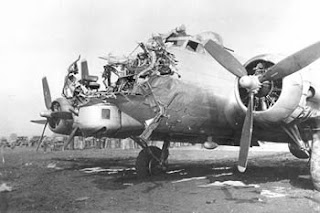During the second World War, bomber planes were heavily used. Both Axis and Allied powers tried to break each others' will to fight by raining bombs on civilians, military forces, railways, harbors and industrial areas. Even though the United States joined the war much later than Britain, the development of bomber aircrafts and the enforcement of strategic bombing greatly strengthened the Allied power. Among dozens of bomber aircrafts, the Boeing B-17 Flying Fortress and the Boeing B-29 Superfortress were the most famous models.
 |
| file:///Users/CW/Desktop/300px-Color_Photographed_B-17E_in_Flight.jpeg |
The B-17 had a wingspan of 103 feet 9 inches and a length of 74 feet 9 inches. With the help of four 1,200-horsepower Wright R-1820-97 engines, the B-17 was able to climb to 35,600 feet and maintain a cruising speed of150 mph.
Over 12,726 B-17's were produced to execute daylight strategic bombing over Europe in WWII. Even though it lacked the range and only had a 9,600 pound bomb capacity, the B-17 contained thirteen machine guns, earning the name of the Flying Fortress. The B-17 also earned a reputation with the Japanese, who called it the “four-engine fighter.”
Its heavily armored body enabled the B-17 to bring crews home safely after taking devastating damage. They often returned to their bases with significant damage to the fuselage.
Like its predecessor, the B-17 Flying Fortress, the B-29 Superfortress had four engines. However, the B-29 was more technologically advanced, with features such as a pressurized cabin, remote-controlled machine gun turrets (twelve .50-cal machine guns and a 20mm cannon), and an electronic fire-control system.
 |
| file:///Users/CW/Desktop/aeb5d-eg.jpeg |
The B-29 had a wingspan of 141 feet and a length of 99 feet. Its maximum cruising range was significantly raised to 5,830 miles compared to that of B-17 (3750 miles). Four 2,200-horsepower Wright Double Cyclone engines paired with the large Fowler flaps were able to lift the 105,000 pound behemoth, while maintaining a top speed of 365 mph.
The B-29 Superfortress was most famous for carrying out the atomic bombings that destroyed Hiroshima and Nagasaki. On August 6, the B-29 "Enola Gay", commanded by Colonel Paul W. Tibbets, departed from Tinian and dropped the first atomic bomb "Little Boy" on Hiroshima. Three days later, the B-29 “Bockscar” dropped the second atomic bomb "Fat Man" on Nagasaki, crippling Japan's will to fight.

No comments:
Post a Comment